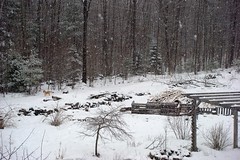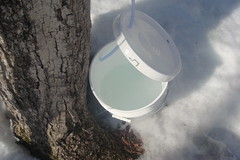 It was supposed to start raining about ten this morning, so we didn’t worry about leaving the sap uncovered to cool. There was half an inch of snow on the ground (and in the sap) at six this morning. One hundred sixty five gallons boiled down to fifteen over the last two days. It’s cold enough that I’m willing to leave it till Saturday to finish on the propane burner. It’s still so cold and snowy in the woods that we should get a good weekend and at least one more good run.
It was supposed to start raining about ten this morning, so we didn’t worry about leaving the sap uncovered to cool. There was half an inch of snow on the ground (and in the sap) at six this morning. One hundred sixty five gallons boiled down to fifteen over the last two days. It’s cold enough that I’m willing to leave it till Saturday to finish on the propane burner. It’s still so cold and snowy in the woods that we should get a good weekend and at least one more good run.
Stuff to keep in mind for next year:
Can the buckets, even for a single tap. There’s no money savings, the lids fly off in the wind, and even if they don’t, the sap ends up full of bark chips, which doesn’t happen with tubing. As the snow melts I’m starting to have trouble with the plastic buckets falling over as well. Some of this is because I cut the drip tube too short, but it’s also that they just don’t stand up on a steep hill. Definitely something to work through for next year.
 There are different colors of sap out there: some of the buckets are yellow, others are bluish like a chlorinated swimming pool. Does this correlate with anything?
There are different colors of sap out there: some of the buckets are yellow, others are bluish like a chlorinated swimming pool. Does this correlate with anything?
The (expensive) tapping bit I bought was too ‘agressive’ and bogged down my (pretty darn good) cordless drill. I backed off to a regular 5/16 bit and all was well. This might have cost me 1 or two seconds per tap. Compared to the time it takes to walk from tree to tree, it’s negligible.
A sugar house is a big deal. Besides a roof to keep rain out of the pan so we can boil any day, four walls to raise the temperature and block the wind would be a massive savings in both time and firewood. Before we build anything, we should cruise not only our land but the neighbors’ and build it big enough to handle all the taps we’re likely to have.
 Pine slab from the sawmill is great fuel for the evaporator. It burn hot and leaves no inconvenient coals at the end of the day. Also we have it and need to make it go away.
Pine slab from the sawmill is great fuel for the evaporator. It burn hot and leaves no inconvenient coals at the end of the day. Also we have it and need to make it go away.
If we want this farm to pay, we need to know the economics of what we’re doing. We now have something of a handle on sugaring.
The two variables seem to be number of taps and evaporation rate. Cost and revenue all follow from those two.
An average tap produces ten gallons of sap, which is one quart of syrup, which this year is roughly ten bucks, after packaging but not cost of sales. Depreciation on the plumbing I’m swagging at a dollar a year per tap. We can set up 250 taps/day, I’m hoping tear down will be the same. That’s an 8-hour day because that’s all we can manage with chores and all the normal life maintenance stuff. That’s 1/125 a day per tap, call it fifteen taps an hour or 4 minutes each. These numbers might improve with time, but I’m concerned that I’m optimistic about sterilizing the stuff. At least for now, we can gather sap while boiling. The evaporator is slow enough that we can leave it to make a sap run, so I’m not counting that separately.
Another rule of thumb is one cord of dry pine per hundred taps. As long as we’re running the sawmill, slab and branches are free, but must be cut, hauled and stacked at say 2 cords/day. That 1/25 an hour per tap, call it two minutes. So there’s an extra 6 minutes per tap of work which needs to be factored in.
The other issue is evaporation rate. We’ve gotten 15 gallons an hour out of our hobby unit. With shelter and dry wood, I’m comfortable we could get 20. That’s two quarts, which after depreciation on two taps is $18/hour gross revenue. There’s also depreciation on the evap: Say $4k (2k each for evap and building) over 20 years is $200/year over 20 days of season (HA!) is $10/day or $1.25/hr. (What with heat up time and clean up, I’m going to call that an 8 hour day too.) So, we can make 16 quarts or 4 gallons of syrup per day. After depreciation on 16 taps and the fixed equipment, (Tractor and chainsaw are on whole-farm depreciation.) that’s $134 income per day.
Besides the boiling time, there’s 6 minutes per tap of labor. Times 16 taps, that’s 96 minutes. So $134/9.60 is $13.96 an hour in a world where everything goes right (including no health insurance being ok). Even if everything was paid for, that’s not enough. With mortgage, college loans and health insurance, that’s not close to enough.
I have plenty of time to crunch these numbers in my head while gathering sap, but I’m tired of typing them, so I’ll do the numbers on a bigger operation some other time.
ZenCart now seems to be coexisting correctly with WP. I bought the FM so I can get it set up soon and, if not get rich, start to get the roving out of the house. The trick was to edit all the .htaccess files and restart apache. If I ever change my permalink scheme it’s all to do again. Hope you like what I have ;).
However I’ve developed a weird and annoying CSS(?) issue. For some reason I can’t use a <br> tag in the center column or it will kick all the text below it down below the end of the left sidebar. Honestly, I’m not sure how this is possible, but it’s there in both FireFox and IE. I don’t grok CSS, so it’s a serious issue. I’ve managed to get <br> out of most templates, but the comment form just really needs them. Perhaps a table. With fixed width columns there’s really no practical or even religious problem with a table.
Note to self: Look into the resolution homesteaders are likely to be using. I’d like to upgrade from 800×600 as a design point, but I’m not sure I dare.
Hi Frank, what makes the evaporator an evaporator? I.e. what does it have that, say, a typical wood stove doesn’t?
Also, what kinds of maples are you tapping? You mention different colors of sap, interesting — are you mixing them or evaporating them seperately (and seeing whether one has more sugar than the other). Any difference in where the tree is located, kind of soil, trees nearby, etc.?
Thanks
Reed
A maple syrup evaporator is a very specialized stove. Here’s a page with pictures of a fancier one than ours. Basically it’s a long open topped firebox (called an arch because that’s the shape of a cast one) with the chimney at one end. and the grate at the other. The bottom of the pan is the top of the firebox and the flames lick along it.
To quote Noel Perrin, “The chimney is traditionally twice as high as the arch is long. There are those who would say your fire is too high if flames actually come out the chimney.”
I’m trying to tap only sugar maple. I may have made an occasional mistake and have a red maple or two as well. The color of the sap doesn’t seem to correlate with much. I don’t have a refractometer to check sap sweetness, nor enough sap to segregrate for experiment. For the moment I’m just noting this to remember.
Frank, your number crunching is certainly impressive, but honey…lighten up. You’re making my head hurt. Sugaring is traditionally a little less intense of an activity. It gives itchy farmers something to do after a long winter and before the ground is ready, creates a nice social moment as we travel to each other’s place and help gather sap or boil, and provides a quality of “sugar” for our lives that is superior to anything. Oh, yeah, and you can sell it.
A sugar house will greatly increase your production and reduce your time; don’t get over fancy, and remember ventilation (lots). The yellow sap typically indicates a tree further along in the season, and approaching the point where you want to stop gathering. Keep your nose in the mix; when the sap begins to smell “off”, you know you’re done. The lighter color stuff (almost bluish-green) yields a more delicate flavor.
Consider using the tubing to collect from “clusters” of taps into a larger tank. We find that is a nice balance between dozens and dozens of pails, and miles of tube which is difficult to clean and store.
So far, we seem to be running about 43 gallons of sap per gallon of syrup over here (Eastern NY) and our season pretty much ended this weekend, but it was a better run than the last two years.
Lastly, if you have a storage shed or designated area for collection, you can accumulate wood for the evaporator all year long, almost as a part of farm clean-up and running the sawmill. And that doesn’t even count all the knitting you can do while you’re boiling (*grin*) …where are those figures?
Melanie, I admit to venting frustration here. But the fundamentals are also true. The farm needs to pay. We made $210 worth of honey last year and lost $225 worth of bees over the winter. Sustainability is this decade’s buzzword and that’s not sustainable. I’ve got lots of time to figure while backing the tractor out the logging road on lowest gear range.
“Clusters” was exactly what I did. I didn’t have the hubris to try a big network from the get go. It worked well except for needing something more stable than a five gallon bucket to collect the sap in. I’m trying to figure what that might be.
Thanks for the info on sap color. I’d actually guessed that, but since I had a couple yellow trees back on first run in February I wasn’t willing to make the conclusion.
We had a good run Saturday, but today was poor here although Lisa says that both New Hampshire and Vermont Public Radios were reporting a good run all over both states. It would be nice to get a few more gallons.